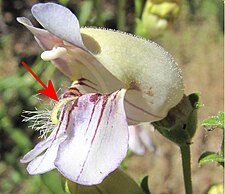This articleneeds additional citations forverification.(September 2024) |
Inbotany,astaminodeis an often rudimentary, sterile or abortivestamen,which means that it does not producepollen.[1][page needed]Staminodes are frequently inconspicuous and stamen-like, usually occurring at the inner whorl of the flower, but are also sometimes long enough to protrude from the corolla.[citation needed]

Sometimes, the staminodes are modified to producenectar,as in the witch hazel(Hamamelis).[2]
Staminodes can be a critical characteristic for differentiating between species, for instance in the orchid genusPaphiopedilum,and among thepenstemons.
In the case ofcannas,the petals are inconsequential and the staminodes are refined into eye-catching petal-like replacements.
A spectacular example of staminode is given byCouroupita guianensis,atropical treegrowing in South America also known as the cannonball tree.